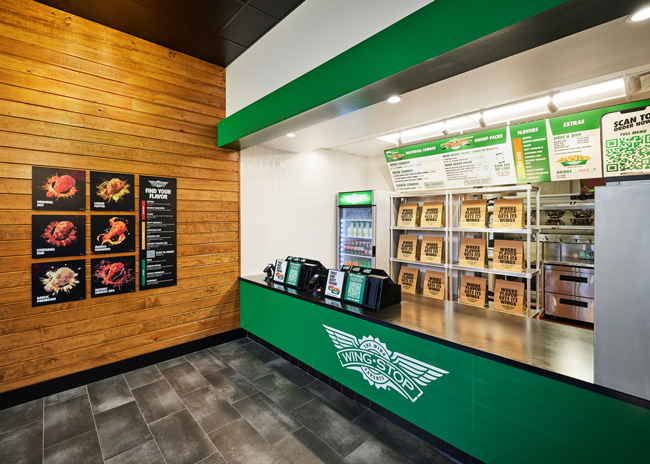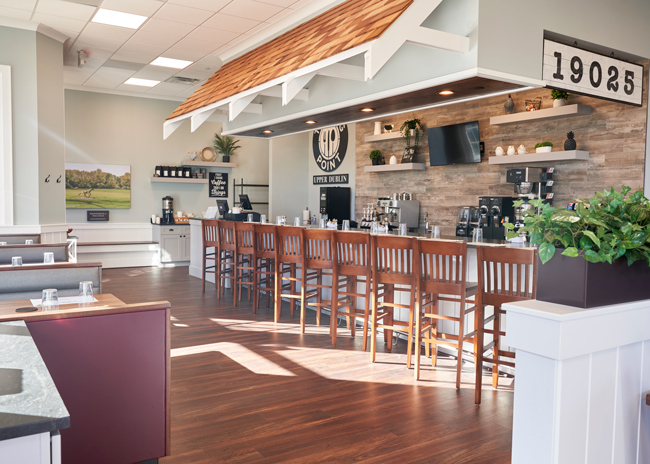 Nick Reader started out with a love of both food and football (he’s a former chief financial officer for the Tampa Bay Buccaneers), joined forces with his friend Bob Basham (co-founder of Outback Steakhouse), and created PDQ in 2009.
Nick Reader started out with a love of both food and football (he’s a former chief financial officer for the Tampa Bay Buccaneers), joined forces with his friend Bob Basham (co-founder of Outback Steakhouse), and created PDQ in 2009.
The owners of the Tampa,Fla.-based chicken tenders chain have, from its inception, focused on from-scratch cooking. Design has always been a key component, with open kitchens an early-on decision as a way to emphasize food integrity. This year, the chain charts a refresh course as it implements a design reboot. Currently at 60 units in 11 states, the majority in Florida, growth plans include adding 30 new units in the next two years, which includes adding Utah as a new market.
What’s the first thing customers will notice in the new design?
NR: The new logo and mascot are noticeable additions and add a lot from a branding standpoint. The creation of our new chicken mascot came from pop artist Burton Morris. It was a six-month creative process with a lot of back-and-forth and feedback.
We love the way it reflects our personality as a chain. The thumbs-up sign the chicken is giving represents the fact that we don’t take ourselves too seriously.
How has the restaurant decor changed?
NR: From a pure decor standpoint, we previously had too many different materials. There was too much going on. For example, we had four different shades of wood in play and three different shades of green on the walls. We have simplified that — for instance, down to a light and dark wood.
We also fixed some of what I call the Xs and Os — with the store reboot, which I would say is a 2.0 design version — that didn’t age well. The sun really ages things, especially in our primary Florida market, and some of the wear and tear from 1,000 people walking on the floors needed addressing. And we even made some adjustments to make our wood beams look better, too.
What pushed you toward the need for a redesign?
NR: We were hitting on five years on some of the buildings. Sometimes, because we live so close to it, we are very observant. We wanted the design of our stores to reflect the A-plus quality in everything in our stores, from the food quality to our people and hospitality.
Will you tweak any of the design elements now that the first redesign store opened?
NR: Yes. Our first redesigned store opened December 10 last year. We’ll open two more before making any adjustments; I think we are 80 percent there. Overall, I’d say it looks slightly more unfinished than I would like. We’re working on nailing it down.
What subtle elements changed that might not jump out at customers right away?
NR: We want to make sure we stay cognizant of just how different it looks going forward. People that eat here once a week might not even be able to tell you what our colors are.
Still, we want to make sure customers know it’s the same operation. We actually reached a point where, internally, we were thinking of putting the old flags up outside the stores instead of the new ones to make sure customers connected that it was the same PDQ store. You have to make the connection.
How does the new design support the chef-driven principle differently?
NR: From the standpoint of the kitchen space, it’s all about ergonomics and efficiency. We eliminated some wasted space. We spent time with our operations people to see exactly how far the staff needs to walk from the point they take lettuce out of the cooler to get to the spot where they cut it. The goal is all about being more efficient. Everything is now within arm’s reach.
Additionally, the goal is to have sight lines into the dining room as well. With the way labor is going and the fact that it can be difficult to find good people in some markets, we’re working hard to design everything smarter.
How has the size of the kitchen space changed in relation to the dining area?
NR: We redesigned the building a little bit with slightly less seating based on feedback from guests. We started out with building approximately 4,400 square feet total. Our new building is closer to 2,800 square feet, with about 1,200 of that in the back of the house.
PDQ incorporated open kitchens long before it was trending in the industry. How do you stay ahead of the curve?
NR: We don’t try to stay ahead of the curve at all. If you do that, you run the risk of chasing what’s “in,” and we don’t look at it that way. We are not driven by trends and data design-wise.
We consider what we want to be great at: food and hospitality. Having an open kitchen helps us do what Bob Basham and I envisioned as founders, which was to provide true, from-scratch food in an environment where people can watch. Just like at your house, people like to hang out in the kitchen space.
Another design convenience at our stores is the placement of hand sinks outside bathrooms. While the parents are in line, they can still keep one eye on their children washing their hands. And the hand sinks operate with a foot pedal, which offers another convenient feature for anyone worried about germs and the flu.
Did the menu change with the redesign?
NR: We will always keep a very focused menu approach at PDQ with hand-breaded chicken tenders as the star. Last year, we added premium sandwiches and bowls to the mix. We also expanded our sides with rice and garlic broccoli.
We do a lot of chef and athlete partnerships for charity that create some unique offerings. In Houston, a sandwich created with B&B Butchers & Restaurant featured blue cheese, bacon, honey and black truffle mayo. Chef John Rivers from 4 Rivers Smokehouse also collaborated with us in the Tampa area to create the 4 Rivers Smokehouse Sandwich, a barbecue chicken sandwich dipped in 4 Rivers’ signature sauces and topped with avocado herb sauce and shredded cabbage are a lot of fun and raise money for different charities.



